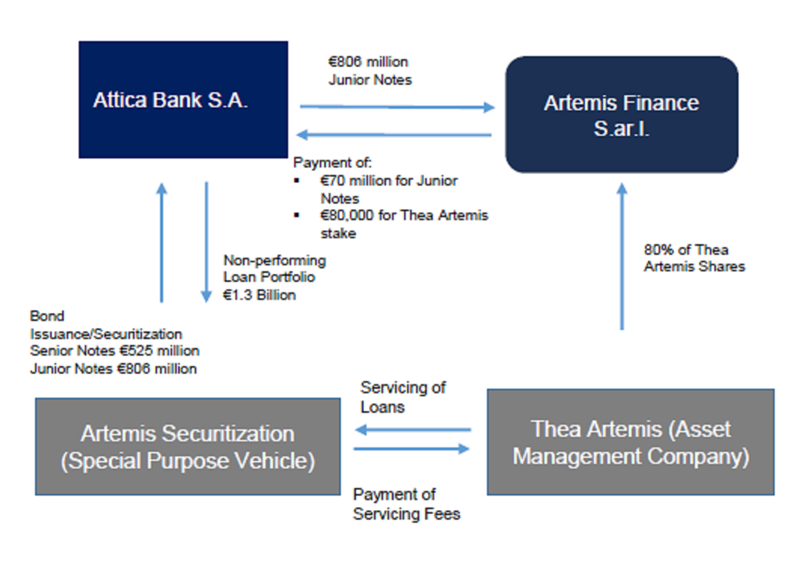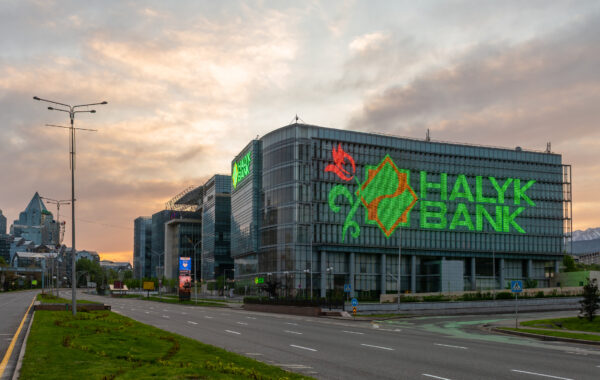Share reorganisation and recapitalisation
The whole process began with a securitisation (Artemis) in Q317. Then, during Q218, there was one reverse share split with write-offs, followed by a share capital issue and a second securitisation (Metexelixis). We will first detail the share split and capital increase, before providing more detail on the two innovative securitisations.
The reverse share split was 14.18 to 1, leaving the bank with 164.9m shares with a nominal value of €4.25. Subsequently, the share capital was reduced by: a) the write-off of €419m of accumulated losses; and b) the formation of a special €233m reserve. These deductions left share capital at €150m, consisting of 165m ordinary shares with a nominal value of €0.3. The bank’s 286m preference shares with a nominal value of €0.35 were unchanged. The special reserve was formed for use in the second securitisation (Metexelixis).
The next stage was recapitalisation. In late April, the bank sought to raise €198m through the issue of four new shares to every existing share at an offer price of €0.3, with pre-emptive rights to existing shareholders. This offer was 44.9% subscribed, raising €88.9m. Consequently, there are currently 461.3m shares in issue and total share capital is €238m.
A ground-breaking solution to NPEs
Prior to the first securitisation, Attica established an NPL asset management company, Thea Artemis. Thea Artemis signed a 10-year agreement to manage the assets of Artemis Securitisation, an SPV established to receive a €1,331m NPL portfolio transferred from Attica Bank. To fund the acquisition, the SPV issued a €525m senior note and €806m junior note to Attica.
The bank retained the senior note, which will be repaid, together with 3% interest, from collections from the SPV portfolio. Following an open tender process, the junior note was sold to Aldridge EDC Speciality Finance at a €70m profit. Aldridge also acquired an 80% interest in the asset manager Thea Artemis for €80,000.
Exhibit 3: Structure of Artemis securitisation
|

|
|
|
Exhibit 4: Impact of securitisation on gross impaired loans and LLA
€m |
2016 |
Artemis |
Other |
2017 |
IFRS 9 |
Other |
Q218 |
Metexelixis |
Pro forma |
Gross impaired loans |
2,422 |
(1,331) |
99 |
1,189 |
|
|
1,291 |
(700) |
591 |
LLA |
1,208 |
(806) |
73 |
475 |
98 |
6 |
579 |
(357) |
222 |
Net value impaired loans |
1,214 |
(525) |
15 |
715 |
(12) |
- |
703 |
(343) |
369 |
Gross lending |
3,985 |
(1,331) |
13 |
2,667 |
|
(51) |
2,616 |
(700) |
1,916 |
|
|
|
|
|
|
|
|
|
|
LLA/gross impaired loans |
50% |
|
|
40% |
|
|
|
|
37% |
Impaired/gross lending |
61% |
|
|
45% |
|
|
|
|
31% |
Source: Attica, Edison Investment Research
Recognising that the bank no longer has contractual rights over the cash flow from the loan portfolio, Attica deconsolidated €1,331m from NPEs and an associated €806m from the LLA. This was matched by the €525m senior bond issued to Attica by the SPV, leaving the group’s net tangible assets unchanged.
The Artemis securitisation was responsible for nearly halving gross impaired loans on Attica’s balance sheet at the end of 2017 (Exhibit 4). An equally important benefit was the €70m premium to written-down value that Aldridge was prepared to pay for the junior note, sending a positive signal that liquidation of the SPV would be sufficient to cover both senior and junior notes.
Following on from the success of Artemis, a second securitisation was undertaken in Q218, with the bank transferring a portfolio of €700m of impaired loans to a new SVP (Metexelixis, or ‘transformation’ in English). The SPV issued and transferred to the bank a €343m senior note and €357m junior note secured against the portfolio. A tender process saw three interested parties compete to acquire the junior note, with the winner, PIMCO, paying a €47m premium. After accounting de-recognition expected in Q3, NPEs are anticipated to drop to €591m or about one-quarter of the level before the two securitisations. Likewise, Attica’s exposure net of the LLA, will equate to 79% of net tangible assets, down from c 250%.
A feature of both securitisations is that the size of the junior note tranche exactly equals the LLA against the impaired loans transferred to the SPVs. Allocating the LLA to the junior notes implies that they are fully protected and, not surprisingly, PIMCO and Aldridge have paid a combined €117m premium to acquire them. This leaves the senior bonds supported by the collateral associated with the impaired loans, which needs to be realised if the bonds are to be repaid.
This collateral, consisting primarily of commercial and residential real estate is extensive; the combination of LLA plus collateral represented 99.7% of impaired loans at the end of 2017 (Exhibit 5), a figure that has subsequently risen to 105.3% for H118. Assuming the impaired loans are 100% covered, they will be protected by €868m of collateral (€2,031m less €1,163m LLA). Provided this collateral can be realised, it will be sufficient to repay the €868m of senior notes. However, Aldridge and PIMCO must believe the eventual realisations will be in excess of this figure, otherwise they would not have paid a premium for the €1.16bn of junior notes, where repayment is clearly more doubtful. The stability of real estate prices is a key risk but, this factor apart, the probability that more than €868m can be realised from a portfolio of €2,031m of impaired loans looks good, and gives an implicit break-even rate for the senior notes of 43% (868/2,031).
In any event, the securitisation transactions are irrevocable, which means that the loans will not come back on to Attica’s balance sheet – although the notes could be written-down if it became apparent that sufficient collateral could not be realised. On the plus side, it is conceivable that Aldridge/ PIMCO will realise collateral quicker than expected, in which case the senior notes could be repaid before their redemption dates, enabling the proceeds to be redeployed in high-yield SME lending.























